
- Homepage
- Culture
- Decade
- Features
- Antique (3)
- Antique / Vintage (3)
- Carving (19)
- Carvings (18)
- Crackled, Distressed (2)
- Distressed (2)
- Easy To Clean (2)
- Flag (7)
- Foldable (5)
- Folding Feet Rest (2)
- Framed (5)
- Framed, Signed (5)
- Pre-shrunk (3)
- Realistic / Lifelike (2)
- Reclaimed (29)
- Salvage (16)
- Wall Mountable (28)
- Wall-mounted (3)
- With Doors (3)
- Other (2849)
- Provenance
- Style
- Type
Antique Vintage American Indian Navajo Rugs Germantown Pictorial Dazzler's
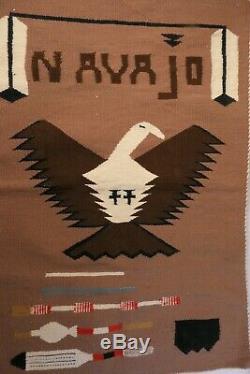
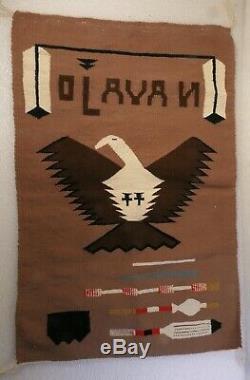
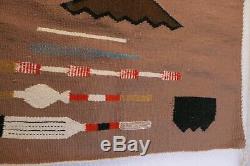
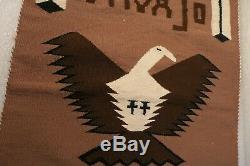

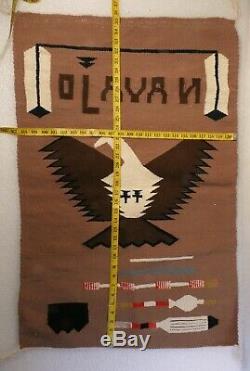



Size 36 inches x 23 inches. Collection of Jamie Ross see other listings thanks.......... Many mistakes arent meant to be corrected. A few summers ago I spent an hour or so wandering through an offbeat galler.
Y specializing in Navajo rugs. Actually, it was even more specialized that that. The collector, a curious character named Jamie Ross, liked to collect Navajo rugs with English words, letters, or language woven into the designs. I was intrigued by some of the designs so I asked him about the history of some of the pieces.
Jamie is the kind of guy who turns a quick ten second question into a slow ten minute answer. That was fine by me, I had nowhere else to be. He explained a lot of things. He talked about his fascination with letters and words and why he especially liked them when they showed up on Navajo rugs.
He also talked a bit about crazy quilts, another one of his obsessions. But there was one thing he said that really stuck with me. I asked him why a lot of the rugs seemed to have mistakes woven into the patterns. Obvious distortions in the patterns, stray lines, or a shape that was just a bit off compared to the other shapes in the piece.
He said there are many explanations. One popular one is that the Navajo intentionally weave mistakes into their rugs to remind them that man isnt perfect.
That sensibility can also be found in the Wabi-sabi art of Japan. But he preferred another explanation.
He said the mistakes werent intentional. What was intentional was the desire not to go back and fix them.He said the Navajo saw mistakes as moments in time. And since you cant change time, why try to change a mistake that already happened?
The mistake is already woven into the fabric of time. Its good to be reminded of it when you look back. Further, he compared it to climbing a mountain. If you climb a mountain you are sure to have a few missteps along the way.
You dont stop and start over if you trip here or take the wrong path there. You cant remove that step. It happened, its part of the climb. And when the climb is done, youve finished.
As long as you made it to the top, you dont call the climb a mistake. Likewise, the Navajo dont call a rug with some off stiches a mistake. If the rug is finished, its a successful rug. More importantly, a rug with a few off stitches is an honest rug.
Now, I dont know if this is Jamies own personal interpretation, or something others Navajo scholars (or Navajo themselves) can back up, but it doesnt matter to me. I love the idea regardless. The idea for the project was inspired by Jamie Ross, a longtime collector of Navajo Blankets. The collection itself is housed in Mineral Point, Wisconsin, and includes over 700 blankets that vary in design and age.
This is an important collection that needs to be viewed not only for its beauty but for the window into the history of Navajo weaving that has occurred in the past 100 years. Current motivations to collect Navajo weaving continue to reflect nineteenth-and early twentieth-century trends, even as new perspectives are gained.
Collectors common interest in regional rug styles reflects a tendency to categorize and then collect one of every type, just as the emerging scientists of the nineteenth century did. Throughout the twentieth century, modernization around the Navajo Nation has produced in both makers and collectors an urge to preserve or even revive earlier forms. And qualities before they are lost to later generations. In addition, the long-recognized tension between craft and art plays itself out repeatedly as outsiders recognize the fresh visual appeal and intricate technology of Navajo weaving.
And as art historians emphasize aesthetic development and anthropologists focus on cultural dynamics, public perceptions swing between the visual images and the artists personal identities. The relatively new element added to this mix of collector motives is the investment quality of weaving. Along with painting, sculpture, and prints, textiles have become profitable commodities in todays art world. The intention of the project was to photograph each blankets but later developed into the idea of creating a book as well as exhibition dedicated to Navajo weavers, history, and the stories that are woven within. Rugs from the collection of Jamie Ross. The Navajo people are more than just unmatched craftsman, theyre also storytellers who weave tales of courage, historic deeds and wondrous imagination into the very fabric of their Pictorial Rugs. From timeless landscapes to traditional celebrations to large, geometric designs, Navajo weavings are truly a joy to experience.They deftly capture the imagination by capturing the past, present and future in stunning, colorful detail. Be it stories of old or todays pop culture, Navajo weavers create masterful works of art that represent a wide range of lifes most precious experiences. Crafted to tell the stories of a people rich in historical significance, Pictorial Rugs have long allowed the Navajo to share everything from common motifs, such as feathers, animals, and locations, to things that hold personal value to the individual weaver. Made sparingly before the 1940s, theyve become major collectors pieces since the 1970s. Many of the scenic Pictorial weavings are made using bold colorations with a distinct stylish flair, from blue skies and vivid pine trees to the red cliffs of New Mexico.
Pictorial weavings are an important connection between the Navajo cultural beliefs, heritage and their love for a beautiful art form. Its important to know that every Pictorial rug is not only handmade, its created from the memory and vision of the individual weaver. As no two people see an object, person, place or thing exactly the same, no two rugs will ever be exactly the sameeven when made by the same person. Images depicted by the artist are carefully designed through laborious work, and only after many hours of thought, mathematics, balance of design and color, can the image begin to take shape and be shared.
For generations, the Navajo have chosen specific patterns, pictures, shapes and designs to tell stories, share history and create memories using innovative Pictorial rug weaving practices. Today, youll find that Nizhoni Ranch Gallery weavers offers Navajo weavings with landscapes, sacred imagery and unique designs with bold use of color, natural wool and unmatched imagination. Whether youre looking to share in their stories or simply enjoy their art style, theres nothing like the hand made, stunning and unusual quality in one of these weavings. Nearly 150 years ago, traders provided the Navajo with brightly-colored, factory-made yarns for their weaving.
These generic, yet colorful yarns eventually became known as Germantown rugs because of where the yarns originated from. Even though, by the early 1900s the yarn trading slowed significantly, the name and the beautiful stylizations did not, as is evidenced by the now popular Transitional Eye-Dazzler rugs that were spawned from this era and continued forward to contemporary weaving. Philadelphia, Pennsylvania, may not be a city you imagine influencing a Navajo Indian rug styling, but they were, in fact, notable for the spawning of the term Germantown rugs in the late 1800s. These intricately styled and often colorful rugs were so aptly named because the yarn that they came from was produced in the now suburb of Philadelphia calledyou guessed itGermantown. The item "ANTIQUE VINTAGE AMERICAN INDIAN NAVAJO RUGS GERMANTOWN PICTORIAL DAZZLER'S" is in sale since Sunday, March 22, 2020. This item is in the category "Collectibles\Cultures & Ethnicities\Native American\ US\1935-Now\Rugs & Textiles (Navajo)". The seller is "lhowardestates" and is located in Minneapolis, Minnesota. This item can be shipped worldwide.- Handmade: Yes
- Country/Region of Manufacture: United States
- Artisan: Misc.
- Provenance: Ownership History Available
- Origin: North America
- Tribal Affiliation: Navajo

